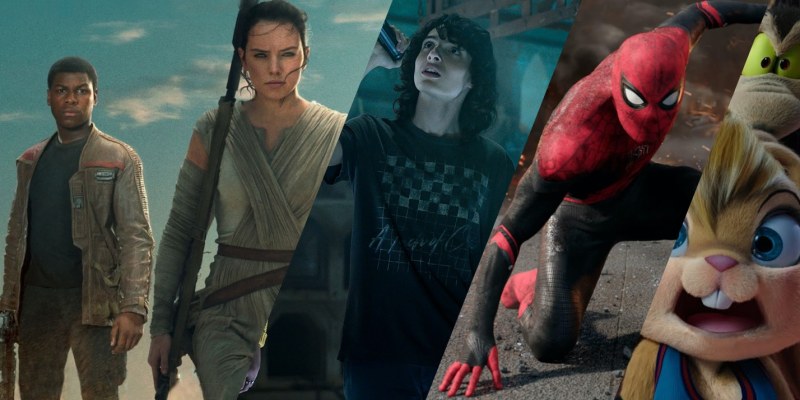This article about the effects of Star Wars: The Force Awakens on Hollywood contains spoilers for Spider-Man: No Way Home.
This Christmas marks the sixth anniversary of the release of Star Wars: The Force Awakens, and it has become increasingly clear with each passing year that Hollywood learned exactly the wrong lessons from the first of the Star Wars sequels.
In the lead up to its release, Matt Singer argued that its arrival signaled the cultural dominance of what could be described as “the legacyquel,” a particular kind of franchise extension that managed to draft in older characters to pass the torch to the next generation. Singer cited J.J. Abrams’ Star Trek as an example of this, a film that allocated a sizable supporting role to Leonard Nimoy as Spock while also introducing an entirely new primary cast in a soft reboot of the Star Trek property.
This approach made sense in the context of 2015. After all, pop culture was increasingly dominated by established intellectual properties that traded on familiarity. At the same time, many of these intellectual properties were quite old, and so many of the stars of those franchises had graduated into the role of elder statesmen. At their best, these films could bridge the generations and gracefully hand these beloved properties from one generation to another.
These legacyquels would be a way of splitting the difference between the familiar and the unknown, between the old and the new. At their best, like in Ryan Coogler’s Creed, this mode of franchising would allow new voices and new perspectives the opportunity to take the stage while allowing an older generation to bow out gracefully. It allowed older characters and actors one last hurrah while also acknowledging that times change and stories change with them.

The Force Awakens suggested a very fine balance around this. The movie is steeped in nostalgia. The Millennium Falcon is treated as a fetish object. Rey (Daisy Ridley) is introduced as a fan of the original Star Wars films, literally living in the ruins of the original trilogy while cosplaying and geeking out. At the same time, its characters felt new and interesting. Finn (John Boyega) was a former stormtrooper, a kind of character who had never been foregrounded in a Star Wars film before.
Naturally, the movie brought back the aging cast of the original Star Wars, including Harrison Ford, Carrie Fisher, and Mark Hamill. The Force Awakens was built around the return of Ford’s dashing smuggler Han Solo. However, this nostalgia is tempered by an understanding that all things end. The climax features the death of Solo, with Ford arguing that it was “a fitting use of the character” within the story. It was similar to the death of Obi-Wan Kenobi (Alec Guinness) in the original Star Wars.
The Force Awakens was a massive critical and commercial success. It earned extremely positive reviews at both Rotten Tomatoes and Metacritic. It earned an “A” CinemaScore from audiences. It went on to become the highest-grossing movie of all time at the domestic box office and the best-selling DVD/Blu-ray of 2016. This sort of success breeds imitation, much like the success of the original Star Wars led to a wave of imitators like Dune or Flash Gordon.
Part of the success of The Force Awakens derived from its ability to balance its various competing demands in the same way that a Jedi must learn to balance the Force. The presence of veteran actors and characters, not to mention a narrative framework imported wholesale from the original Star Wars, served to reassure more conservative and traditionalist fans. However, the presence of young and dynamic leads with their own stories ahead of them helped ignite a new and younger base.

Hollywood has never been particularly good at learning the right lessons from its success stories, so it’s no surprise that the studios struggled to understand the give-and-take at play in The Force Awakens between the past and the future. The film did look backwards in its plotting and its supporting cast, but it also had one eye firmly on what might lie ahead. In the six years following the success off The Force Awakens, many of its imitators have chosen to look in only one direction.
This is obvious looking at the trajectory of the Star Wars franchise. It’s interesting to compare The Force Awakens to The Rise of Skywalker, the final film in the sequel trilogy. Both films feature returning characters and actors in prominent roles, but The Force Awakens understands that those elder statesmen are there in a supporting capacity for the newer cast. The Rise of Skywalker aggressively reverses the dynamic, reassuring audiences of the importance of their old favorites.
In The Rise of Skywalker, original trilogy veterans like Lando Calrissian (Billy Dee Williams) and Palpatine (Ian McDiarmid) leapfrog over younger cast members like Poe Dameron (Oscar Isaac) or Kylo Ren (Adam Driver). It’s made clear that Rey’s story is not her own, but is instead entirely defined by her attachment to existing older characters. Her powers come from her lineage as Palpatine’s secret granddaughter, but she redeems herself by taking the name of Skywalker.

This is reflective of broader trends. Older characters in these belated sequels rarely exist to support a new generation. Instead, the younger cast exists largely to glorify and venerate what came before. It often feels like an effort to repackage old content instead of driving interest with something new. This is perhaps literalized within Space Jam: A New Legacy, a movie literally about an algorithm recreating Space Jam that could have been made by an algorithm recreating Space Jam.
Ghostbusters: Afterlife is a prime example of this approach. The end of the movie doesn’t stay with new characters Phoebe (Mckenna Grace) or Trevor (Finn Wolfhard) but follows the familiar ECTO-1 back to New York City with veterans Peter Venkman (Bill Murray), Ray Stantz (Dan Aykroyd), and Winston Zeddemore (Ernie Hudson). There’s no real acknowledgement that maybe these characters have earned retirement and that maybe they should hand their toys down to a younger generation.
It’s also at play within Spider-Man: No Way Home, which blends Sony’s current Spider-Man franchise with the two previous live-action iterations, with both Tobey Maguire and Andrew Garfield reprising their roles from earlier films. The film is weirdly dedicated to servicing and celebrating these earlier films, in ways that often distract from what the film is trying to say or what it is trying to do with the version of Peter Parker played by Tom Holland.

This is most notable with the version of Peter Parker played by Andrew Garfield, from the maligned Amazing Spider-Man movies. Both of the other versions of the character spend time reassuring him that he is not “lame.” A key action beat at the climax involves Garfield’s version of Peter Parker saving a falling M.J. (Zendaya), a sequence that plays as a somewhat forced redemption of his failure to save Gwen Stacy (Emma Stone) at the end of The Amazing Spider-Man 2.
None of this feels like it adds much to No Way Home itself beyond fan service and in-jokes. It feels shallow when compared to the superficially similar mentoring relationship between Peter B. Parker (Jake Johnson) and Miles Morales (Shameik Moore) in Spider-Man: Into the Spider-Verse. Crucially, the final scene between Peter and Miles hinges on Peter recognizing that he is a supporting player in Miles’ story, letting Miles make his own choices and face his own villain.
The Force Awakens was a movie about how great it is to see old friends again and giving an older generation one last bow before gracefully surrendering the stage to a younger cast. Franchise filmmaking might be in a much healthier state had Hollywood embraced and internalized that idea. Instead, the years since have seen franchises fixate on nostalgia for its own sake, an ouroboros of familiar content, gorging itself on reheated leftovers from a bygone era.
